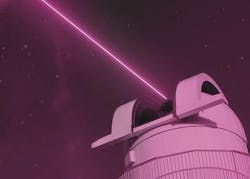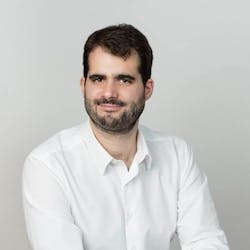Jean-François Morizur loves a good challenge. He started with a dual Ph.D. program at Pierre and Marie Curie University in France and the Australian National University and a nontraditional entry as an industry analyst at Boston Consulting Group (BCG), and his independent spirit helped him to carve his own path in photonics.
His work at BCG opened doors of opportunity. While at BCG, Morizur received a call from his former Ph.D. supervisor about work he’d done at the university. This call ultimately led to a company of his own.
A significant discovery
At the time he was conducting his Ph.D. research, the goal was to develop a quantum computer. Morizur focused on a method that could take spacially entangled photons and mix them to shape the desired entanglement. This new approach was called multi-plane light conversion (MLPC). By placing mirrors in different areas and manipulating them, light can be formed into different shapes.
Morizur had conversations with telecom researchers at the time who told him what he was trying to achieve was physically impossible, but he realized he was onto something that would have a real industry impact.
Although the science was there, the application wasn’t yet. It took years for his team to identify a way to commercialize the solution, but they continued their journey to develop a product that effectively matched his theory.
The makings of a company
In 2013, Morizur launched Cailabs and began fundraising. At the time, most investments were directed toward software as a service (SaaS) models, which made a hardware photonics company based in France an unlikely funding priority. Venture capitalists (VCs) interested in Morizur’s technology had their hands tied by these market drivers. But when faced with financing rejections, Morizur stood adamant that MLPC would work in the market and pivoted toward VC funds that could support photonics.
Perseverance pays off
After years of effort, Morizur secured funding and Cailabs began real work. By 2017, the company had built a collaborative model where the product was be developed in-house. Custom designs gave the company and its team an independence and autonomy to evolve their solutions within the market, although in an iterative way.
At the same time, the company ramped up staffing to build their bench expertise. As Morizur points out, if a product requires integration with electronics, electronic experts need to be on board. So he hired staff with expertise in mechanics to focus on optics.
From Swiss Army knife to sushi knife
A shift in business direction—from creating a generalized product to offering client-specific solutions—helped Cailabs find its niche. Morizur’s mindset shifted from delivering a do-it-all product to asking the client: “What problem do you need us to solve?” He likens it to a Swiss Army knife vs. a sushi knife. Instead of an “it-can-do-anything-you-need” approach, their product messaging shifted to offering a very sharp solution designed for a specific purpose. In short, Cailabs pivoted from a Swiss Army knife to a sushi knife, and this change positioned them as a consultant that offered more value because they partnered with the client to identify solutions for their needs.
Making this leap required a strong leadership team at Cailabs. Morizur knows the customer isn’t always right. As their partner, the Cailabs team asks the appropriately hard, strategic questions to navigate unintended bias based on past experiences or procedures to provide thoughtful solutions.
On the other side of the business proposition, Cailabs recognizes that overly customizing their solutions may make them only viable for one client and the need to be strategic in maximizing their investment. So Morizur adopted an 80/20 approach to give clients 80% of what they need to avoid very nuanced requirements or a product that’s 80% there, with only 20% customization necessary.
Diverse solutions for diverse markets
This approach to productization led Cailabs to focus on three key markets: aerospace and defense, industrial laser processing, and fiber networks. Tailoring solutions to client specifications means the company often ends up in situations where they develop and sell prototypes, and then put them into small-scale production.
Solutions like their CANUNDA Configurator for laser welding, additive manufacturing, and microprocessing scale up production for a wide variety of industries. This sort of volume balance for products enables generating them in one production facility. There are similarities between products, so the team can leverage efficiencies across the board.
On the horizon
What’s next? Aerospace is becoming a quick-moving market, and when a telecom client suggested back in 2017 that it was an industry to consider, the team began to explore it. They quickly saw its potential and began scaling products for optical ground stations, and today operate one of the first optical ground stations capable of 10+ Gbit/s laser communications with low Earth orbit (LEO) satellites. Morizur says the company achieved 180% growth within this market during the past few years.
But this growth wouldn’t be possible without his team at Cailabs. Morizur applauds his team’s scientific prowess, which he says leads to the intellectual honesty that drives company and product vision. With Guillaume Labroille, cofounder and chief technology officer, Morizur focuses on company strategy, but a large part of it requires ensuring that his team is equipped with what they need to succeed.
Within the next five years, Morizur predicts more expansion in both optical ground stations and industrial lasers and knows Cailabs’ products will be a central part of this evolution. The Cailabs team is already hard at work laying the building blocks for tomorrow. Morizur says they’ll keep on evolving—building unique products to serve the needs of today, while also planning for what’s ahead. Never one to back down from a good challenge, Morizur continues to expand the company with the needs of the industry, one solution at a time.
About the Author
Jose Pozo
Chief Technology Officer, Optica
Jose Pozo joined Optica in March 2022, and has spent more than 25 years working in photonics. He earned a PhD in quantum physics from the University of Bristol (U.K.), and an M.Sc. and B.Eng. in telecom engineering from UPNA, Spain / VUB (Belgium). Prior to joining the European Photonics Industry Consortium (EPIC) in 2015 as CTO, Jose was a Senior Photonics Technology Consultant with PNO Consultants, with some of the main accounts such as CERN, Thales, and TE Connectivity. He has worked at TNO, The Netherlands Organization for Applied Scientific Research, and as a postdoctoral researcher at the Eindhoven University of Technology in the Netherlands, where he contributed to the early development of EFFECT Photonics.

